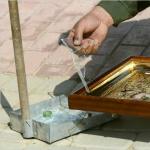Lighting engineering is actively introducing LEDs into lighting. In addition to LEDs, there are also COB LEDs on the market. They are based on more powerful emitters. LED lighting elements COB (Chip On Board) are light sources with which you can save on energy consumption. But experts continue to argue which lamps are best to use. What Chip On Board LEDs are and what features they have, we’ll talk about this further.
Appearance on the market
In semiconductor lighting technology until 2009 there was only one direction - increasing the power of the diode glow. This direction is called Power LED, which means “powerful LEDs”. Scientists were able to invent a lamp whose power reached up to 10 W. But, as a rule, emitters with a power of 1 to 6 W were in great demand.
Since 2009, SMD diodes have appeared on the market. This technology means that the device is attached to the surface using soldering, and each diode is covered with a layer of phosphor. Such lamps are low-power and create diffused light due to a large number of diodes (up to seven hundred pieces).
The next step in development was the COB technology, which stands for “numerous crystals on a board.” The essence of Chip On Board is that crystals are attached to the board without a housing and without ceramic substrates. Then all crystals are covered with a uniform layer of phosphor. Due to this, the lamp will shine evenly. This design made it possible to significantly reduce the cost of LEDs.
The COB LED device is shown in the picture:
Manufacturing technology
The advantage of IDS over SMD is that only 70 crystals are placed per square centimeter. This means that the size of the lamp is significantly reduced, but the rage remains unchanged.

Chip On Board matrices are manufactured using a specific technology, which includes the following steps:
- the substrate is coated with a special adhesive composition, which provides adhesive properties;
- installation of crystals on a substrate;
- hardening of the adhesive layer, which performs a protective function;
- cleaning the matrix from contamination using plasma technology;
- soldering the board and crystal contacts to each other;
- coating with a phosphor, which is mixed with silicone (the latter is necessary for sealing the crystals).
The most difficult stage in this technology is the uniform application of a very thin layer of adhesive material. In order for the crystals to attach to the substrate, it is necessary to apply a thin layer of glue, but it must be of a specified thickness. If this layer is thin, the crystals will fall off during use. If the layer is thick, there is insufficient contact between the substrate and the element (thermal output decreases).

The issue was resolved by Chinese scientists who proposed a method by which the adhesive layer is applied evenly, thereby improving thermal contact. This method is called magnetron sputtering. The improved matrices are now called Multi Chip On Board. Today, almost all COB matrix LEDs are manufactured using this technology, thereby creating high-power lamps.
Characteristics and parameters of LEDs
The use of modern technological processes makes it possible to produce lamps that use the SOV matrix with a power of up to 100 W. And the light output reaches 150 Lm/W. A typical Chip On Board matrix comes in two shapes: round and square. Its dimensions (diameter and side, respectively) range from 1 to 3 cm.

But there are Chip On Board LEDs in larger sizes. Manufacturers of the SOV matrix give the product a service life of up to 30,000 hours, and more powerful LEDs can operate up to 50,000 hours.
Such indicators have led some experts to believe that Chip On Board has low reliability. These figures about the service life of the product were obtained through mathematical research. The LEDs were tested under extreme conditions, and the result yielded the following values: in continuous mode, the device can operate for up to six years. Over such a long time, other more powerful and better product models will appear.
But you should remember that all manufacturers of lighting elements based on the Chip On Board matrix provide a warranty period of up to 20,000 working hours. If something happens during this time, they are ready to carry out free repairs.
Of course, IDS matrices also have disadvantages, but they are not as significant compared to their advantages. Lamps with such a matrix are more expensive than conventional ones, but if you calculate the energy consumption, it is obvious that LED lamps are more profitable.
So we looked at Chip On Board LEDs, their advantages, characteristics and design. We hope that the article provided was useful and interesting for you!
You probably don't know:
LEDs are becoming increasingly popular solutions in a variety of areas. They can be used as decorative products or for lighting indoors, as well as various areas outside buildings. LEDs are supplied to the market in a fairly wide range of modifications. At the same time, developers of relevant products periodically offer innovative solutions that in the future can create new market niches. What are the most common types of LEDs today? For what purposes can they be used?
What are LEDs?
Before considering common types of LEDs, let's study general information about the corresponding devices. An LED is a semiconductor that is capable of converting electrical current into light. In this case, the semiconductor crystal, which is its main component, consists of several layers characterized by 2 types of conductivity. Namely - hole and electronic.
Conduction of the first type involves the transfer of an electron from one atom to another, which has a free place. In turn, another electron comes to the first atom, another electron comes to the previous one, etc. This mechanism operates due to covalent bonds between atoms. In this case, they do not move. In fact, a positive charge moves, which physicists conventionally call a hole. In this case, when an electron passes to holes, light is released.
The structure of an LED is generally similar to a rectifier diode. That is, it has 2 terminals - anode and cathode. This feature predetermines the need to maintain polarity when connecting the LED to an electric current source.

In general, the corresponding products are designed for a forward current of 20 milliamps. In principle, this value can be reduced, although in this case the color may change and the brightness of the LED may decrease. In turn, it is undesirable to increase the corresponding parameter. If the current exceeds the optimal value, a limiting resistor is used to reduce it to the required level.
There are quite a few nuances that should be kept in mind when installing LEDs. This is predetermined by their internal structure and form of execution. In some cases, it may be necessary to use a stabilizer for LEDs and other electronic components to ensure the functioning of the device in which the product in question is installed.
Depending on the composition of the semiconductors in the LED, it can be red, yellow, green or blue. For example, if the structure of the corresponding electronic component contains gallium nitride, the LED will glow blue. Actually, one of the criteria based on which certain types of LEDs are distinguished may be their color.
Application
The first LEDs supplied to the market were produced in metal housings. Gradually it began to be replaced by plastic. In this case, the color is usually selected taking into account the color of the LED glow. However, transparent plastic cases are also quite common.
The electronic devices under consideration are widely used in a variety of fields. This is due to the fact that almost everyone is characterized by:
Energy efficiency;
Long service life;
The ability to determine the color of the glow, as well as adjust its power;
Security;
Environmentally friendly.
If we talk about energy efficiency, LEDs with the same luminous efficiency can have significantly less power than conventional lamps. The lower power of the LED reduces the overall load on the building's energy system. The service life of devices can be several tens of times longer than that of conventional lamps. At the same time, in terms of functions, LEDs can be completely on par with them.

As mass demand for such products develops, as well as their cost, LEDs are increasingly used for the same purposes as conventional lamps. There are no difficulties in installing the corresponding solutions in comparison with traditional lighting devices. It is only important to make sure whether a particular LED is suitable for installation in the electrical network of the room. To do this, it may be necessary to identify its main parameters in advance - before purchasing LEDs.
What other benefits might the solutions under consideration have?
Thus, it can be noted that the color temperature of the LED can be almost any - including a combination of the above colors. In addition, the devices can be supplemented with various light filters, which can significantly expand the scope of LEDs in terms of selecting the required color temperature.
The ability to control the glow power is another advantage of the devices in question. This option goes well with their high energy efficiency. The LED power can be adjusted automatically - based on the actual conditions of use of the lighting fixtures. And this practically does not affect their service life.
LEDs are environmentally friendly because they do not emit types of radiation harmful to humans. This characteristic, again, expands the application possibilities of the devices in question.
Classification: indicator and lighting solutions
Experts distinguish 2 main categories of LEDs - indicator and lighting. The former are intended mainly to create a decorative lighting effect and are used as an element of decoration of a building, room, or vehicle. Or as a tool for text stylization - for example, on an advertising banner.
In turn, there are lighting LEDs. They are designed to increase the brightness of lighting in a room or in a certain area of the territory - for example, if we consider LEDs for cars. This type of solution is an alternative to the use of conventional lamps and in many cases more beneficial in terms of energy efficiency and environmental friendliness.
Types of execution
But let's return to the classification of LEDs. It is possible to define a wide range of reasons for their classification into certain categories. A common approach among experts involves identifying the following main types of LEDs:
Fiber;
Let's take a closer look at them.
What are the specifics of DIP LEDs?
If we study in more detail how these types of LEDs appeared on the market, then DIP class devices can be attributed to the first that began to be sold en masse. These solutions are crystals that are placed in housings with optical components, in particular a lens that creates a light beam.

DIP LEDs belong to the indicator category. They have another name - DIL. They are installed on a board on which holes must first be made. It can be noted that within the category under consideration, various types of LEDs can be distinguished, which differ in the diameter of the bulb, color, and material of manufacture. In this case, the corresponding parameters can be presented in the widest range. The shape of the solutions under consideration is cylindrical. Among the corresponding LEDs there are both monochrome and multicolor devices.
Spider LED
This type of LED is generally very similar to previous devices. But they have twice as many outputs - 4. While DIP LEDs have 2. The fact that the presented type of solution has more outputs optimizes heat dissipation and increases the reliability of the corresponding components. In practice, they are used in various fields, in particular as LEDs for cars.
SMD LEDs
These solutions are produced using the surface mounting concept. That is, they are LEDs installed on any surface, while other solutions can be installed through through-hole mounting.
The dimensions of LEDs of this type can be significantly smaller than those of alternative solutions, as well as the structures on which they are installed. Again, in this case it is legitimate to talk about more optimal heat removal. Using SMD LEDs in many cases it allows you to expand the variability of lighting designs.

SMD LEDs belong to the lighting category. They are characterized by a rather complex structure. So, the LED itself consists of a metal substrate. A crystal is fixed on it, which is soldered directly to the contacts of the substrate body. A lens is placed above the crystal. In this case, 1-3 LEDs can be installed on one substrate. SMD includes common types of ultra-bright LEDs, such as 3528. These solutions have a high level of demand.
COB LEDs
The next popular type of LED is COB. It is made using technology that involves installing the crystal directly on the board. This solution has many advantages:
Protection of the compound from oxidation;
Small design dimensions;
Heat dissipation efficiency;
Reducing the installation cost of LEDs - in comparison, in particular, with SMD-type devices.

If we consider the above types of LEDs, it can be noted that COB brand solutions can be classified as the most innovative. This technology was first implemented by Japanese engineers in the late 2000s. Now these types of LEDs continue to gain popularity.
According to experts, the solutions under consideration may even become the most popular on the market, especially if we talk about the commercial segment and the field of household lighting. It is worth noting that there are areas where the use of COB LEDs may be difficult. Among these is the production of professional lighting equipment. The fact is that the LEDs in question are not very optimal from the point of view of adapting to the organization of lighting with an established luminous intensity curve. In such cases, SMD type devices may be more suitable.
The diodes described are classified as lighting diodes. As experts note, they can be classified as the best based on the characteristics of the luminous flux. They are available in the market in different colors such as red, green, blue and also white. The luminous flux of these models has a dispersion angle of 40-120 degrees.
More than 9 COB LEDs can be installed on one substrate. They are coated with a phosphor, as a result of which they acquire high brightness. It can be noted that the luminous flux of these solutions is higher than that of SMD devices. Thus, if we consider which type of LEDs is better, then according to the specified criterion, a COB class solution may have an advantage.
COB LEDs are also used in the automotive industry. They can be used as a component of front, rear lights, and turn signals. The main thing is to install the purchased devices correctly. To do this, it makes sense to turn to experienced specialists.
Fiber LEDs
Fiber LEDs can be considered innovative. They appeared on the market recently, in 2015. The solutions in question were developed by engineers from South Korea.
These types of LEDs can be used in the production of clothing. That is, it is quite possible to make a shirt or T-shirt from them that can glow. The production of clothing based on fiber LEDs also involves the use of various polymers, as well as aluminum compounds.
Filament LEDs
Another example of innovative LEDs is Filament solutions. Their main advantage is high energy efficiency. For the same power, with LEDs such as COB, for example, Filament solutions can provide higher levels of illumination.
The one in question is most often used in the manufacture of one. Among the notable characteristics of the production of the corresponding LEDs is the installation directly on a substrate made of glass. This approach makes it possible to distribute the light emitted by the LED over 360 degrees.

How to choose the best option?
How to determine the type of LED that is optimal for a particular design? There are a large number of criteria that you can focus on in this matter. In principle, it is quite legitimate to determine the scope of application of an LED based on its classification according to the characteristics that we discussed above. Let's study the specifics of choosing the appropriate electronic components, taking into account the characteristics of the devices:
Selecting LEDs: features of DIP solutions
As we noted above, DIP LEDs are among the earliest products to hit the market. Thus, they involve quite old, but still in demand technologies. Their main advantages are ease of installation, convenient form, low energy consumption, low heating, and a fairly high degree of protection from external influences.
Most often, the LEDs in question are available in diameters of 3 and 5 mm. If we compare LEDs by type, we can come to the conclusion that the solutions under consideration are the most optimal for use:
As elements of car tuning;
As decorative components;
As part of low-power - as an option for homemade - flashlights.
The LEDs in question have a relatively low cost and availability on the market. It can be noted that among the most common modifications are 12 volt LEDs. They can be present in various online catalogs, as well as specialized stores in a wide range. Actually, any 12 volt LEDs are characterized by a fairly high demand on the market.
Selecting LEDs: features of SMD type solutions
The corresponding type of solution is fundamentally different in appearance from others in that it has a flat shape. These electronic components are mounted without the use of feet. The current for SMD type LEDs is supplied to the terminals that are located on their reverse side.
Thus, the installation of these devices is carried out without the use of holes. The placement of LEDs can be done very compactly. As a result, the structure on which the corresponding devices are located may also become smaller.
The main ways of using the devices in question are the same auto-tuning, various types of interior lighting. Among the most significant advantages of these options are high brightness and light output. Combined with their small size, these solutions offer significant advantages over alternative product models.
Among the most common on the modern market is the 3528 LED type. These products are widely used in the production of LED strips. The design of the corresponding products allows the production of three-color LEDs - with red, blue, and green glow colors. Many other electronic components are manufactured based on the 3528 type solutions, such as the SMD 5050 type LED.
The products in question are also characterized by their affordability. They are usually presented on the market in a wide range.
Selecting LEDs: Features of COB Solutions
First of all, it is worth noting that a significant part of the LEDs of the corresponding type are very powerful designs. Their characteristic feature is the rapid dispersion of light, thanks to the placement of crystals on the surface, which provides dynamic heat dissipation.
The LEDs in question are very bright. This makes them in demand specifically for use in the design of car headlights. It is worth noting that these products should be installed taking into account a number of significant nuances - only experienced specialists can know these. Therefore, it is recommended to contact competent service personnel to install appropriate solutions.
Light-emitting diodes (LED) and radiating diodes AL, 3L– semiconductor radiation sources with direct voltage from 1.35V before 3.0V and direct current strength from 5mA before 300mA. The luminous intensity varies depending on the denomination from 0.02 μd before 350mcd.
The presented emitting diodes are divided into three types: light emitting diodes(LED), emitting infrared diodes(IR) and character-synthesizing indicator LEDs(AL304 red and green glow). Other names for LEDs are also widespread: indicator LEDs, round DIP LEDs (Dual In-line Package), DIL LEDs (Dual In-Line - “in two rows”), LED LEDs (Light Emitting Diode).
Phosphidogalium epitaxial LEDs AL, 3L are presented in several options color glow: red, yellow, green. Infrared emitting gallium arsenide diodes are mesa-epitaxial or mesadiffusion.
Are being manufactured in a metal-glass or metal case with an optically transparent or diffuse-scattering compound, as well as in a plastic case. Conclusion unidirectional radial, flexible, wire type. The anode lead is slightly longer, sometimes thicker, and the cathode lead can be marked with a small section of the housing.
When connecting you need observe polarity. It is also prohibited to connect LEDs directly to a power source. Resistors must be used as a limiting current stabilizer. In this case, a separate one is connected to each chain of series-connected LEDs. current limiting resistor, which also applies to parallel connection.
Some LEDs and emitting diodes AL, 3L are additionally marked with colored dots or rims on the body.
Installation carried out using THT technology (leads are mounted directly into through holes of the printed circuit board) using soldering. Emitting diodes of types AL119, 3L119, AL123, 3L123, AL124, 3L124 are mounted on additional heat sinks.
The increased operating temperature of the environment is no more than +85°С, reduced operating temperature – not lower -60°С. Power losses do not exceed 500 mW. Angle of light from 8° before 120°. Service life not less 15,000 h.
apply as light-emitting sources in various lighting devices and decorative colorful lighting. Infrared diodes AL, 3L are used in remote control devices, photonic communication lines, transceiver devices, and various sensors.More detailed characteristics, explanation of markings, overall dimensions indicating the polarity pinout of LEDs and emitting diodes AL, 3L are listed below.
The warranty period for LEDs and emitting diodes AL and 3L supplied by our company is 2 years, which is supported by relevant quality documents.
The final price for LEDs and emitting diodes AL, 3L depends on the quantity, delivery time, manufacturer, country of origin and form of payment.
Modern lighting technology is increasingly gravitating towards the use of LEDs. But the newer the technology, the more questions it raises. What types of LEDs are there? What type of LEDs should I choose? Which technology is the most reliable? You will find answers to these and other questions in this article.
An LED is a semiconductor device that converts electrical energy into light. The luminous element of an LED is a semiconductor crystal having a multilayer structure of thin films of semiconductors with different types of conductivity - hole and electronic.
Hole conduction is associated with the transfer of an electron from another atom to an atom with a free place. The atom from which the electron passed receives another electron from another atom, etc. This is due to the covalent bonds of the atoms. Thus, a positive charge moves without moving the atom itself. This conditional positive charge is called a hole.
In contact zones of different types of conductivity, p-n junctions are formed. Such multilayer structures are called heterostructures.
When an electric current passes through the region of p-n junctions, recombination of holes and electrons occurs (electrons occupy vacant positions - holes), accompanied by the emission of light. This radiation can be red, yellow, green or blue - depending on the composition of the semiconductors in the heterostructure. Heterostructures consisting of layers of gallium nitride (GaN) with certain impurities emit blue light.
In lighting engineering, an emitting gallium nitride crystal with pads for contact wires is usually called a chip. The chip is the key component on the basis of which the LED itself is assembled.
To produce white light, a phosphor is applied to the chip - a chemical substance that is excited by radiation emanating from the crystal and emits its own radiation. This combines LEDs with compact fluorescent lamps - there is also a phosphor inside the tube.
The chip is coated with a layer of silicone-based gel with phosphor powder so that part of its radiation is absorbed in the phosphor substance and excites it, and part of it passes through the phosphor freely. As a result, mixing the initial blue glow of gallium nitride with the yellow glow of the phosphor produces white light. Using different phosphors, any color temperature of the emitted light can be achieved.
The LEDs themselves are made on the basis of an emitting crystal coated with a phosphor and equipped with electrical contacts.
Depending on the assembly technology, there are currently 4 types of LEDs.
1. DIP LEDs.
The first LEDs for mass use appeared in this format. The crystal is placed in a housing with a built-in optical system - a special lens that forms the desired light beam.
Today this is the most widespread type of LEDs, but it is practically not used in modern high-tech light sources. It is mainly used in light displays, backlights, and various festive lighting decorations.
2. Piranha LEDs, Superflux LED or Spider LED.
They have a design similar to their predecessor, but their difference is that there are not 2, but 4 outputs. This improves heat dissipation and provides greater reliability during installation. Because of this, this type of LED is common in the automotive industry.

It is practically not used in lighting today due to its size and installation complexity compared to more modern types of LED designs.
3. SMD LEDs.
LEDs of this type are manufactured using surface mount technology TMP (surface mount technology) or SMT (surface mount technology). Hence its name SMD - surface mounted device - a device mounted on a surface.

The main difference between this technology and the "traditional" through-hole technology is that the components are mounted on the surface of the board. This ensures smaller design dimensions, better heat dissipation, and design variability.
This design is the most common in lighting today and is used in almost all types of light sources.
4. COB technology.
COB (Chip-On-Board - chip on board) is a technology in which a crystal chip is mounted (attached, soldered) into a board, and the highest reliability (protection of the contact from oxidation), miniature size and heat dissipation are ensured. In addition, the production cost of such LEDs is lower compared to SMD LEDs.

COB technology was first used in Japan in the late 2000s by Citizen and Sharp. They were the first to use a ceramic plate with low thermal resistance as a circuit board for an LED. Currently, both aluminum and ceramic boards are used, and the volume of LED production using this technology is about 20% of all LEDs produced and is constantly growing.
The fact that more LED manufacturers around the world are starting to produce COB LEDs shows that this technology is well positioned to soon take a leading position in commercial and residential lighting for many years to come. But, nevertheless, it is worth noting that COB technology cannot completely replace SMD due to a number of technical limitations and disadvantages. For example, for professional lighting with a given luminous intensity curve (for street or narrow-beam lighting), COB technology is not applicable. In addition, if a uniformly luminous light source is needed (for example, a large area ceiling lamp), it is better to use many small SMD LEDs.
In conclusion, it is worth noting that LED lighting is becoming increasingly popular today. The high growth rates of this market contribute to the development of new LED production technologies and expand the boundaries of their use. In modern office and residential environments, as well as in outdoor lighting, many applications previously seemed firmly anchored in classic types of light sources. Today, these postulates are subject to revision: LEDs provide not only cost savings, but also ample opportunities to create high-quality lighting for life, work and creativity.
The main direction of lighting technology is the introduction of LEDs into lamps of all kinds and types. But it should be noted that there is no single direction for this development. Today, in addition to well-known LED lamps, so-called COB lamps, which are based on more powerful LEDs, are also entering the market. LED COB lamps ( Chip-on-Board)- these are essentially the same LED light sources with which everyone wants to save energy consumption. But disputes are still raging among experts, in which the parties cannot agree on how to choose the right one.
It is believed that in modern lighting technology until 2009 there was only one direction of development - an increase in the glow power of diodes. Both then and today this direction is called Power LED (powerful LED). Scientists managed to achieve significant results - LEDs with a power of up to 10 W were born. Although 3-6 watt devices remain in demand.
What is the essence of the Power LED concept? In principle, everything is quite simple - reduce the cost of light sources. It was believed that increasing power, and therefore brightness, would reduce the number of LEDs. But in reality none of this happened. The cost of Power LED lamps has not decreased, and the light output has not increased much. Why did it happen?
- The first reason is that the LED is and has always been a point source of light. But for the basic operating conditions of any lamp, diffused light is required. Therefore, diode lamps for the home were provided with special optical systems. Without them, the light source emitted high-power brightness, and the flow was blinding. But there are two more factors: firstly, the optical systems themselves were expensive, and secondly, through them the lamp itself lost a certain amount of brightness (up to 35%).
- The second reason is that the assembly of LED lamps using COB diodes involves a fairly large amount of manual labor. So here, too, expenses greatly influenced the cost of the product.
Breakthrough
Since 2009, SMD diodes have appeared, the power of which is 0.01-0.2 watts. LEDs of this type consist of 1-3 crystals, which are glued to a ceramic square base with dimensions from 1.4 to 6 mm. And each point diode is coated on top with a phosphor. The most important thing is that the LEDs are connected to the plateau using the soldering method. This means that the entire technological process can be fully automated, avoiding expensive manual labor.

But that's not all.
- SMD diodes are low-power; for one lamp you have to install them in large quantities (up to 700 pieces). And this is one hundred percent scattering light. That is, there is no need to use expensive and complex optical systems. The best option is a lampshade made of ordinary glass, whose light loss is only 8%.
- The LEDs are located on the plateau at certain intervals, which are several times larger than the size of the crystals themselves. That is why the diodes themselves are so clearly visible individually, and not in the total mass. In addition, it is possible to increase the optimal glow in rooms where there is a computer. You can simply install lamps with milky LEDs.
The only disadvantage of SMD lamps is their low maintainability. It is almost impossible to disassemble and re-solder a burnt-out diode manually. So it is better if you completely replace the lamp with a new one. It won't cost much.
The breakthrough continues
So, back to the COB LED lamp topic. No one was going to give up these LEDs, it was just necessary to modify the lamp itself, making it inexpensive. There were several options for changing the design, but one turned out to be optimal.

- Firstly, they abandoned ceramic substrates. That is, the crystals began to be installed directly on the plateau.
- Secondly, all crystals were covered with a single layer of phosphor. Therefore, the lamp glows evenly without visible individual luminous points.
And here COB matrices began to win over SMD matrices. In the circuits of 220 V LED lamps there are up to 70 crystals per square centimeter. That is, the lamp becomes several times smaller, but its brightness was not inferior to other models. Eventually, it became possible to use both reflectors and diffusers in light sources of this type, which are installed on traditional lamps.
Production process
COB dies are manufactured in several automated steps.
- An adhesive composition is applied to the substrate, which will provide high adhesive properties.
- Installation of crystals.
- Hardening of the glue.
- Cleaning the matrix with plasma technology.
- Soldering crystals from the plateau.
- Application of phosphor.
Attention! In this technology, the phosphor is mixed with silicone. The latter ensures complete tightness of the light structure.

The most difficult technological operation, which until recently was impossible to implement, is the application of a thin adhesive layer. The thing is that the glue layer must be of a certain thickness. If it is thin, the crystals will begin to peel off during use. If it is too thick, the thermal transfer of the crystals to the substrate will decrease. This problem was solved by the Chinese, who proposed using the magnetron sputtering method. Therefore, the new matrices are now called MCOB, that is, Multi Chip-on-Board, which translated means “numerous crystals on the board.” True, this did not change the design of the LED lamp. It is this technology that currently allows the production of high-power LED lamps.
Parameters and characteristics
So, technical specifications. Modern COB luminaires can reach 100 Watts. At the same time, the brightness of the glow reaches up to 150 Lm/W, which is even a very decent indicator.
The dimensions of the matrix (it can be square or round) are from 1 to 3 cm. This is for internal use. For outdoor LED lamps, diodes with a matrix size of 3x12 cm are used. The service life of LED lamps with COB diodes is 300,000 hours, more powerful analogues last up to 500,000 hours.
Some experts, given the short service life, talk about the low ability of this type of lamps. But there is one caveat. Lamp life was tested under extreme conditions. After that, using mathematical calculations, they summed up that they would work continuously for 6 years. And during this time, new lighting devices will probably appear, more economical, reliable and bright.
Attention! Almost all manufacturers provide a warranty period of 200,000 hours, during which they are ready to carry out repairs.

In principle, the technical characteristics indicate that LED lamps are by far the most economical option for a lighting system in the house. Of course, it is also the most expensive in terms of the down payment (price). But it’s worth paying attention to them if the consumer is faced with the problem of saving.
Conclusion on the topic
It is probably no longer a secret for many that many European countries want to abandon electricity generated from the fission of uranium. Nuclear power plants are unreliable. For example, Switzerland will close all nuclear power plants by 2036, although they account for up to 41% of electricity generation. Therefore, Europeans are investing a lot of money in the development of new energy-intensive technologies, where LED lighting is a priority.
And the last thing on this topic. Many consumers are wondering which LED lamps are better, and how to choose the right one? If you have read the article, then you should understand that this question makes no sense.


















